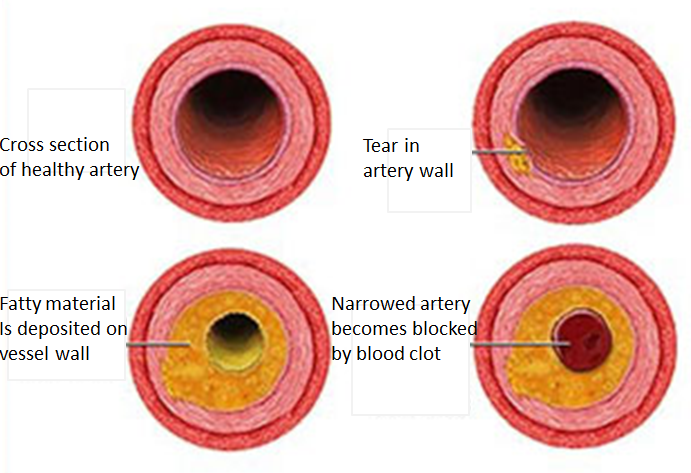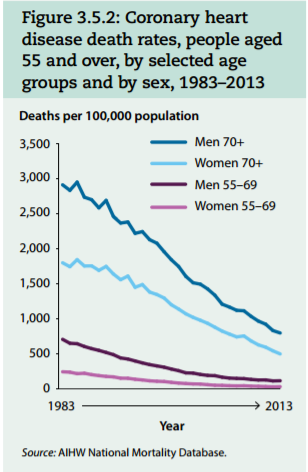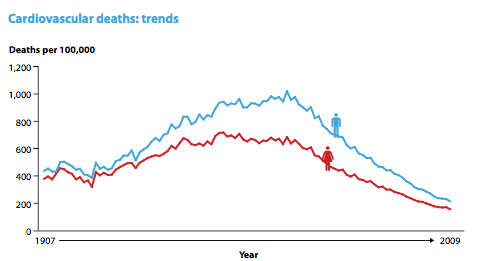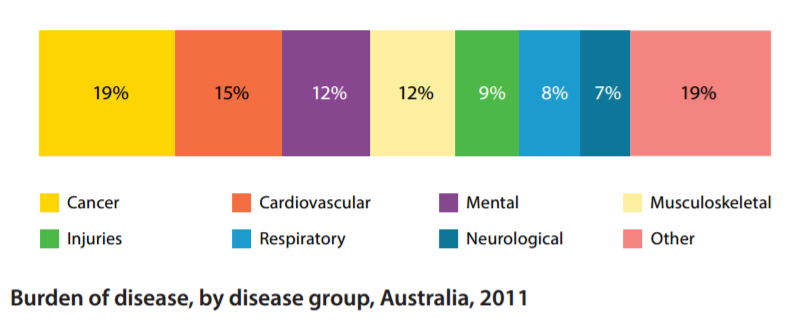The nature of the problem
Cardiovascular disease refers to all the diseases of the circulatory system (heart and blood vessels). These include diseases such as: coronary heart disease, stroke, myocardial arrhythmia, and heart failure. The main cause of many of these diseases is atherosclerosis, which refers to the build up of fat and plaque inside the arteries, which can block the blood vessel. A blockage can result in the death of cells that were relying on these arteries for their oxygen supply – such as in a heart attack.
Coronary heart disease includes heart attacks and angina. While a heart attack results from momentary blockage of the artery to a section of heart muscle, angina results from a partial blockage and produces chest pain, particularly on exertion. A Stroke is a temporary blockage of the blood vessels to the brain, resulting in the death of some brain cells, or a vessel begins to bleed, reducing the delivery of oxygen to part of the brain. Stroke (cerebrovascular disease) can result in a range of debilitations including: communication, mobility, thinking and can also be fatal. Heart failure is a condition where the heart is unable to maintain a strong enough blood flow. It can result in chronic tiredness, reduced capacity for physical activity and shortness of breath. It is a life-threatening condition and cannot be cured in most cases.

Extent of the problem (trends)
1 in 5 Australian’s suffers from a Cardiovascular disease. Cardiovascular diseases are the second leading causes of death in Australia (after cancers), but coronary heart disease is still the leading single cause of death with cerebrovascular disease coming in second. Cardiovascular diseases account for the second largest burden of disease, with both coronary heart disease and cerebrovascular disease in the top five. Cardiovascular disease is also the most costly disease in Australia. The current trend in death rates because of coronary heart diseases is downward – falling 73% in the last 30 years. This downward trend is mostly due to improvements in medical and surgical treatments.
The rate of strokes has fallen by 25% in the last 10 years, while the total number of people who have had a stroke has increased by 6% over the same period. Over a third of people who have a stroke have a resulting disability. Stroke death rates have fallen by 70% over the last 30 years. Hospitalisation rates for stroke have fallen by 17% in the last 10 years.



Risk factors and protective factors
There are many risk factors for cardiovascular disease, but the main ones are: hypertension (high blood pressure), physical inactivity, obesity, and smoking. Many of these risk factors have behavior factors associated with them. Eating high calorie and high fat diets contributes to obesity and can cause cardiovascular diseases. The current trend in Australia for overweight and obesity is upwards. Inactivity can also contribute towards obesity and higher rates of inactivity are associated with cardiovascular disease. Both obesity and inactivity also contribute to hypertension, as does smoking. Smoking also contributes to the plague build up and atherosclerosis, the main underlying cause of cardiovascular diseases. The trend in smoking across Australia is downward, while most others are upwards. Other risk factors include a family history of cardiovascular diseases or their underlying causes.
Some protective factors for cardiovascular disease include: regular physical activity, regular health checks, and eating a balanced diet low in saturated fats.
The sociocultural, socioeconomic and environmental determinants
The sociocultural determinants of cardiovascular disease include: family, media, peers, religion and culture. Genetics play an important role in many chronic diseases and cardiovascular disease is no exception. In addition to the genetic inherited, growing up in a family that is overweight or obese, eats foods high in sugar and saturated fats or lives a sedentary lifestyle leads to children who grow up to live a similar lifestyle and make similar choices concerning these risk factors. Peers can also influence people to make poor health choices, such as pressure to smoke, which can lead to increases in cardiovascular disease.
Socioeconomic determinants of cardiovascular disease include employment, income and education. Education, especially health literacy and knowledge influences lifestyle choices. Higher levels of education help produce lower incidence of cardiovascular disease. Education also enables choice of employment. Cardiovascular disease has higher rates in blue collar employment, such as trades and labour. This is often linked with other lifestyle choices often associated with these forms of employment such as higher rates of smoking and drinking as well as higher saturated fat diets. Lower income levels result in fewer health related choices as many incur cost to the individual, such as joining a gym, or buying lean meats rather than regular meat.
The environmental determinants of cardiovascular disease are geographical location, and access to health services and technology. People living in rural areas have higher rates of death from cardiovascular disease. This could be because the speed of medical treatment for heart attacks or a stroke greatly affects the results. People who access medical treatment swiftly have less chance of disability or death resulting from their stroke or heart attack. Access to technology also impacts survival rates, but also is used in medical checks to test for atherosclerosis, angina and other cardiovascular diseases.
Groups at risk
There are a number of groups at risk of cardiovascular disease. These include:
- ATSI, who have 2.6 times as many heart attacks as other Australians over 25 and are 1.7 times as likely to have a stroke.
- People with low socioeconomic status, who have a 40% higher death rate from cardiovascular disease and higher rates of stroke.
- Rural and remote people, who have a higher burden form stroke compared with people in major cities.
- The elderly, who represent 15% of those who have coronary heart disease and account for 70% of people who had a stroke.
- Smokers have much higher rates of cardiovascular diseases, and
- Men, who have more cardiovascular disease than their female counterparts.
